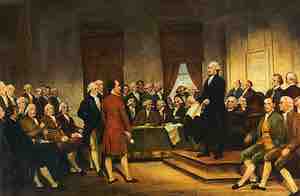Article V of the US Constitution
The Articles of Confederation made amending the law very difficult, as all states had to agree to an amendment before it could pass. A unanimous vote had the potential to completely stall crucial change. However, the Framers of the Constitution worried that too many changes would harm the democratic process. To protect the Constitution from hasty alteration, the framers wrote Article V . This article specified how to amend the Constitution, showing that the Constitution could adapt to changing conditions with an understanding that such changes required deliberation.

Constitutional Convention
The Framers supported a process that would allow the newly created constitution to change, but also made sure it could not be changed too quickly.
Proposing and Ratifying Amendments
There are two ways to propose amendments: First, states may call for a convention. This has never been used due to fears it would reopen the entire Constitution for revision. The other way is for Congress to pass amendments by a two-thirds majority in both the House and Senate.
There are two additional ways to approve an amendment: One is through ratification by three-fourths of state legislatures. Alternatively, an amendment can be ratified by three-fourths of specially convoked state convention. This process was used during the Prohibition era. Those in favor of ending Prohibition feared that the 21st Amendment (set to repeal the 18th Amendment prohibiting the sale and consumption of alcohol) would be blocked by conservative state legislatures. On December 5, 1933, these so-called "wets" asked for specially called state conventions and ratified repeal. Thus it was proved that a constitutional amendment can be stopped by one-third of either chamber of Congress or one-fourth of state legislatures.
Restrictions to the Amendment Process
The amendment process originally came with restrictions protecting some agreements that the Great Compromise had settled during the Constitutional Convention.
The Great Compromise (also called the Connecticut Compromise) was an agreement that large and small states reached during the Constitutional Convention of 1787. In part, the agreement defined the legislative structure and representation that each state would have under the US Constitution. It called for a bicameral legislature along with proportional representation in the lower house, but required the upper house to be weighted equally between the states.This agreement led to the Three-Fifths Compromise, which meant less populous Southern states were allowed to count three-fifths of all non-free people toward population counts and allocations.
Thus, Article V of the US Constitution, ratified in 1788, prohibited any constitutional amendments before 1808 which would affect the foreign slave trade, the tax on slave trade, or the direct taxation on provisions of the constitution. Also, no amendment may affect the equal representation of states in the Senate without a state's consent.